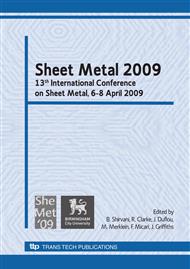p.429
p.439
p.449
p.459
p.467
p.473
p.481
p.493
p.503
A Contribution to the Optimisation of a Simple Shear Test
Abstract:
The finite element method is a widely used tool in sheet metal forming. The quality of the results of such an analysis depends largely on the applied constitutive model and its material parameters, which have to be determined experimentally. These data are relevant on the choice of the yield criterion among the wide range of options available in the commercial applications implementing the finite element method. Since the accuracy of material parameters estimation is therefore crucial, investigations were performed with an Al-Mg sheet alloy and a mild steel sheet to optimize a Miyauchi-based simple shear test. This method is one of the basic ways to investigate the plastic properties of a sheet metal up to large strains, which is very important for numerical analysis of sheet metal forming processes. Aim of the test is to determine the shear stress-strain correlation. In order to enhance the quality of the experimental results the detection of the deformation’s field, trough an optical measurement system, and the methodology for its evaluation are focus of the present study.
Info:
Periodical:
Pages:
467-472
Citation:
Online since:
March 2009
Authors:
Keywords:
Price:
Сopyright:
© 2009 Trans Tech Publications Ltd. All Rights Reserved
Share:
Citation:


